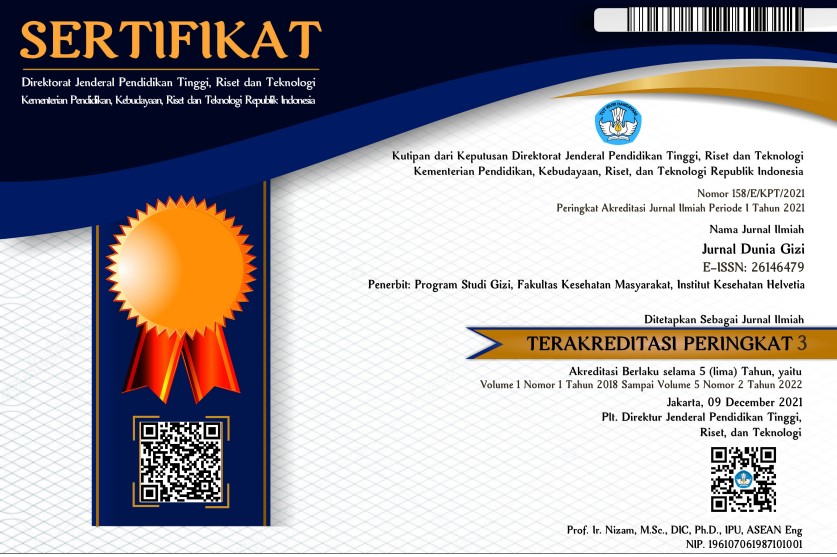Formulation of Mocaf Mie with Natural Colors from Purples Sweet Potatoes
Abstract
Background: Noodle is one of the popular food products in the community. Purple sweet potato contains large amounts of anthocyanin pigment. Seeing the prospect of great benefits and easily obtained, sweet potatoes can be optimized for use as a source of natural dyes. Objectives: The purpose of this study was to determine the nutrient content of wet noodles and the level of preference for noodles from mocaf flour with natural sweet potato dyes. Material and Method: This type of research is an experiment with a completely randomized design (CRD) with 4 treatments and 2 repetitions to produce 8 experimental designs. Results: The hedonic test results obtained the best formula is F1 with a value of 3.67 categories very like while the hedonic quality test obtained the best formula is F1 with a value of 3.68 categories of purplish, slightly aromatic colour, slightly savoury taste and somewhat chewy texture. The nutritional content of wet noodles are 69.02% water content, 3.67% ash content, 1.03% fat content, 9.77% protein content, 0.34% calcium content and 1.493% phosphorus content. Conclusion: The most preferred wet noodle based on hedonic test and hedonic quality is F1 formula. This wet noodle only has a little nutritional content, further research is needed in order to get the best-wet noodle formulation and has a good nutritional content so that it can be produced as an alternative to wet noodle variations.
Keywords
Full Text:
PDFReferences
Safriani N, Moulana R, Ferizal. Pemanfaatan Pasta Sukun (Artocarpus altilis) pada Pembuatan Mi Kering. Teknol dan Ind Pertan Indones. 2013;5(2):17–24.
APTINDO. Asosiasi Prosedusen Tepung Terigu Indonesia. 2016;1–19.
Sunarsi S, Sugeng M, Wahyuni S, Ratnaningsih W. Memanfaatkan Singkong Menjadi Tepung Mocaf untuk Pemberdayaan Masyarakat Sumberejo. 2011;(1).
Badan Pusat Statistik. Produksi Tanaman Pangan. Eb Pangan. 2014;
Zulaidah A. Modifikasi Ubi Kayu Secara Biologi Menggunakan Starter Bimo-Cf Menjadi Tepung Termodifikasi Pengganti Gandum. 2011;
Yanti H, Lubis S, Darus M. Analisis Perbandingan Nilai Tambah Pengolahan Ubi Kayu Menjadi Tepung Mocaf Dan Tepung Tapioka Di Kabupaten Serdang Bedagai. 2012;
Indrianti N, Kumalasari R, Ekafitri R, Darmajana D. Pengaruh penggunaan pati ganyong, tapioka, dan mocaf sebagai bahan substitusi terhadap sifat fisik mie jagung instan. 2013;33(4):391–8.
Ayu K, Rachmawanti D, Sigit B. Kajian Sifat Sensoris Dan Fungsional Cake Ubi Jalar Ungu (Ipomoea Batatas L.) Dengan Berbagai Variasi Bahan Baku. 2014;3(1).
Widyaningtyas M, Susanto W hadi. Pengaruh Jenis Dan Konsentrasi Hidrokoloid (Carboxy Methyl Cellulose, Xanthan Gum, Dan Karagenan) Terhadap Karakteristik Mie Kering Berbasis Pasta Ubi Jalar Varietas Ase Kuning. 2015;3(2):417–23.
Ginting E, Suprapto. Pemanfaatan Pati Ubi Jalar Sebagai Substitusi Terigu Pada Pembuatan Roti Manis. 2004;86–97.
Ihromi S, Susandi YA. Subsitusi tepung terigu dengan tepung mocaf dalam pembuatan kue kering. 2018;5(1):73–7.
Ramadhan A, Sari E. Variasi Perbandingan Tepung Terigu Dan Mocaf (Modified Cassava Flour) Dalam Pembuatan Mie Mocaf. 2015;I(2):211–9.
Marsono Y, Astanu WP. Pengkayaan Protein Mie Instan Dengan Tepung Tahu. 2000.
Sigit B, Atmaka W, Apriliyanti T. Kajian Sifat Fisikokimia Dan Sensori Tepung Ubi Jalar Ungu (Ipomoea Batatas Blackie) Dengan Variasi Proses Pengeringan. 2002. :788–93.
Astawan M. Membuat Mie dan Bihun. 2009.
Nintami AL. Kadar Serat, Aktivitas Antioksidan, Amilosa Dan Uji Kesukaan Mi Basah Dengan Substitusi Tepung Ubi Jalar Ungu ( Ipomoea Batatas Var Ayamurasaki ) Bagi Penderita Diabetes Melitus Tipe-2. 2012;
Tan H, Li Z, Tan B. Starch noodles : History , classification , materials , processing , structure , nutrition , quality evaluating and improving. Food Res Int. 2009;42(5–6):551–76.
Winarno. Kimia Pangan Dan Gizi. PT Gramedia Pustaka Uta-ma. Cetakan ke-9.; 2002.
Rahmi Y, Wani Y, Kusuma T, Yuliani S, Rafidah G, Azizah T. Profil Mutu Gizi, Fisik, dan Organoleptik Mie Basah dengan Tepung Daun Kelor (Moringa Oleifera). 2019;0:10–21.
Rini AW. Pengaruh Penambahan Tepung Koro Glinding (Phaseolus Lunatus) Terhadap Sifat Kimia Dan Organoleptik Mi Basah Dengan Bahan Baku Tepung Terigu Yang Disubstitusi Tepung Ubi Jalar Ungu (Ipomoea Batatas). 2008;
Nugrahani MD. Perubahan Karakteristik Dan Kualitas Protein Pada Mie Basah Matang Yang Mengandung Formaldehid Dan Boraks. 2005;
Lewu MN, Adebola PO, Afolayan AJ. Effect of cooking on the mineral and antinutrient contents of the leaves of seven accessions of Colocasia esculenta ( L .) Schott growing in South Africa. 2009;7(October):359–63.
Sediaoetama A. Ilmu Gizi untuk Mahasiswa dan Profesi di Indonesia. 1993.
DOI: https://doi.org/10.33085/jdg.v2i2.4588
Refbacks
- There are currently no refbacks.

This work is licensed under a Creative Commons Attribution-NonCommercial 4.0 International License.









1.png)







.png)










